A Multi-Frequency Electrical Impedance Spectroscopy Technique of Artificial Neural Network-Based for the Static State of Charge
Abstract
:1. Introduction
2. Multi-Frequency Electrical Impedance Spectroscopy Analysis
2.1. Multi-Frequency EIS Measurement
2.2. Multi-Frequency EIS Measurement
3. ANN-Based Model Introduction
3.1. ANN-Based Basic Introduction
3.2. Back-Propagation Neural Network Design
4. Design of ANN-Based Model for Multi-Frequency Impedance
4.1. Static SOC Database of ANN-Based Model for Li-ion Battery
4.2. Establishing a BPN Model
4.3. Testing the BPN Model of the Training Completed
5. Experimental Results
6. Conclusions
Author Contributions
Funding
Institutional Review Board Statement
Informed Consent Statement
Data Availability Statement
Acknowledgments
Conflicts of Interest
References
- Lee, S.; Kim, J.; Lee, J.; Cho, B. State-of-charge and capacity estimation of lithium-ion battery using a new open-circuit voltage versus state-of-charge. J. Power Sources 2008, 185, 1367–1373. [Google Scholar] [CrossRef]
- Weng, C.; Sun, J.; Peng, H. A unified open-circuit-voltage model of lithium-ion batteries for state-of-charge estimation and state-of-health monitoring. J. Power Sources 2014, 258, 228–237. [Google Scholar] [CrossRef]
- Tong, S.; Klein, M.P.; Park, J.W. On-line optimization of battery open circuit voltage for improved state-of-charge and state-of-health estimation. J. Power Sources 2015, 293, 416–428. [Google Scholar] [CrossRef]
- Roscher, M.A.; Assfalg, J.; Bohlen, O.S. Detection of Utilizable Capacity Deterioration in Battery Systems. IEEE Trans. Veh. Technol. 2011, 60, 98–103. [Google Scholar] [CrossRef]
- Ressela, S.; Billa, F.; Holtza, L.; Janshena, N.; Chicab, A.; Flowera, T.; Weidlichc, C.; Struckmanna, T. State of charge moni-toring of vanadium redox flow batteries using half cell potentials and electrolyte density. J. Power Sources 2018, 378, 776–783. [Google Scholar] [CrossRef]
- Vega, M. Single-Cell Impedance Track™ Gas. Gauge for Novices; Texas Instruments Application Report; Texas Instruments: Dallas, TX, USA, 2007; pp. 1–9. [Google Scholar]
- Chiang, Y.-H.; Sean, W.-Y.; Ke, J.-C. Online estimation of internal resistance and open-circuit voltage of lithium-ion batteries in electric vehicles. J. Power Sources 2011, 196, 3921–3932. [Google Scholar] [CrossRef]
- Coleman, M.; Lee, C.K.; Zhu, C.; Hurley, W.G. State-of-Charge Determination from EMF Voltage Estimation: Using Impedance, Terminal Voltage, and Current for Lead-Acid and Lithium-Ion Batteries. IEEE Trans. Ind. Electron. 2007, 54, 2550–2557. [Google Scholar] [CrossRef]
- Hung, M.-H.; Lin, C.-H.; Lee, L.-C.; Wang, C.-M. State-of-charge and state-of-health estimation for lithium-ion batteries based on dynamic impedance technique. J. Power Sources 2014, 268, 861–873. [Google Scholar] [CrossRef]
- Mastali, M.; Vazquez-Arenas, J.; Fraser, R.; Fowler, M.; Afshar, S.; Stevens, M. Battery state of the charge estimation using Kalman filtering. J. Power Sources 2013, 239, 294–307. [Google Scholar] [CrossRef]
- Mawonou, K.S.; Eddahech, A.; Dumur, D.; Beauvois, D.; Godoy, E. Improved state of charge estimation for Li-ion batteries using fractional order extended Kalman filter. J. Power Sources 2019, 435, 226710. [Google Scholar] [CrossRef]
- Propp, K.; Auger, D.J.; Fotouhi, A.; Longo, S.; Knap, V. Kalman-variant estimators for state of charge in lithium-sulfur batteries. J. Power Sources 2017, 343, 254–267. [Google Scholar] [CrossRef]
- Huet, F. A Review of impedance measurements for determination of the sate-of charge or sate-of-health of secondary batteries. J. Power Sources 1998, 70, 59–69. [Google Scholar] [CrossRef]
- Huang, J.; Li, Z.; Zhang, J. Dynamic electrochemical impedance spectroscopy reconstructed from continuous impedance measurement of single frequency during charging/discharging. J. Power Sources 2015, 273, 1098–1102. [Google Scholar] [CrossRef]
- Kurian, S.; Krishnan, S.T.; Cheriyan, E.P. Real time implementation of artificial neural networks-based controller for battery storage supported wind electric generation. IET Gener. Transm. Distrib. 2015, 9, 937–946. [Google Scholar] [CrossRef]
- Xu, J.; Mi, C.C.; Cao, B.; Cao, J. A new method to estimate the state of charge of lithium-ion batteries based on the battery impedance model. J. Power Sources 2013, 233, 277–284. [Google Scholar] [CrossRef]
- Lipu, M.S.H.; Hannan, M.A.; Hussain, A.; Saad, M.H.M.; Ayob, A.; Blaabjerg, F. State of Charge Estimation for Lithium-Ion Battery Using Recurrent NARX Neural Network Model Based Lighting Search Algorithm. IEEE Access 2018, 6, 28150–28161. [Google Scholar] [CrossRef]
- Wang, Q.K.; He, Y.J.; Shen, J.N.; Hu, X.S.; Ma, Z.F. State of charge-dependent polynomial equivalent circuit modeling for electrochemical impedance spec-troscopy of lithium-ion batteries. IEEE Trans. Power Electron. 2017, 33, 8449–8460. [Google Scholar] [CrossRef]
- Chen, J.; Ouyang, Q.; Xu, C.; Su, H. Neural Network-Based State of Charge Observer Design for Lithium-Ion Batteries. IEEE Trans. Control Syst. Technol. 2018, 26, 313–320. [Google Scholar] [CrossRef]
- Howey, D.A.; Mitcheson, P.D.; Yufit, V.; Offer, G.J.; Brandon, N.P. Online Measurement of Battery Impedance Using Motor Controller Excitation. IEEE Trans. Veh. Technol. 2014, 63, 2557–2566. [Google Scholar] [CrossRef]
- Xing, Y.; He, W.; Pecht, M.; Tsui, K.L. State of charge estimation of lithium-ion batteries using the open-circuit voltage at various ambient temperatures. Appl. Energy 2014, 113, 106–115. [Google Scholar] [CrossRef]
- He, H.; Xiong, R.; Guo, H. Online estimation of model parameters and state-of-charge of LiFePO4 batteries in electric vehicles. Appl. Energy 2012, 89, 413–420. [Google Scholar] [CrossRef]
- Yang, C.; Wang, X.; Fang, Q.; Dai, H.; Cao, Y.; Wei, X. An online SOC and capacity estimation method for aged lithium-ion battery pack considering cell inconsistency. J. Energy Sources 2020, 29, 101250. [Google Scholar]
- Einhorn, M.; Conte, F.V.; Kral, C.; Fleig, J. A method for online capacity estimation of lithium ion battery cells using the state of charge and the transferred charge. IEEE Trans. Ind. Appl. 2012, 48, 736–741. [Google Scholar] [CrossRef]
- Zhang, Y.; Song, W.; Lin, S.; Feng, Z. A novel model of the initial state of charge estimation for LiFePO4 batteries. J. Power Sources 2014, 248, 1028–1033. [Google Scholar] [CrossRef]
- Poloei, F.; Bakhshai, A.; Liu, Y.-F. A novel online adaptive fast simple state of charge estimation for Lithium Ion batteries. In Proceedings of the 2017 IEEE 6th International Conference on Renewable Energy Research and Applications (ICRERA), San Diego, CA, USA, 5–8 November 2017; pp. 914–918. [Google Scholar]
- Xu, J.; Mi, C.C.; Cao, B.; Deng, J.; Chen, Z.; Li, S. The state of charge estimation of lithium-ion batteries based on a proportional-integral observer. IEEE Trans. Veh. Technol. 2014, 63, 1614–1621. [Google Scholar]
- Qingsheng, S.; Chenghui, Z.; Naxin, C.; Xiaoping, Z. Battery state-of-charge estimation in electric vehicle using elman neural network method. In Proceedings of the 29th Chinese Control Conference, Beijing, China, 29–31 July 2010. [Google Scholar]
- Eichi, H.R.; Chow, M. Adaptive parameter identification and state-of-charge estimation of lithium-ion batteries. In Proceedings of the IECON—38th Annual Conference on IEEE Industrial Electronics Society, Montreal, QC, Canada, 25–28 October 2012. [Google Scholar]
- Zhang, H.; Na, W.; Kim, J. State-of-charge estimation of the lithium-ion battery using neural network based on an improved thevenin circuit model. In Proceedings of the IEEE Transportation Electrification Conference and Expo (ITEC), Long Beach, CA, USA, 13–15 June 2018. [Google Scholar]
- Yuan, X.-Z.; Song, C.; Wang, H.; Zhang, J. Electrochemical Impedance Spectroscopy in PEM Fuel Cells; Springer: London, UK, 2010. [Google Scholar]
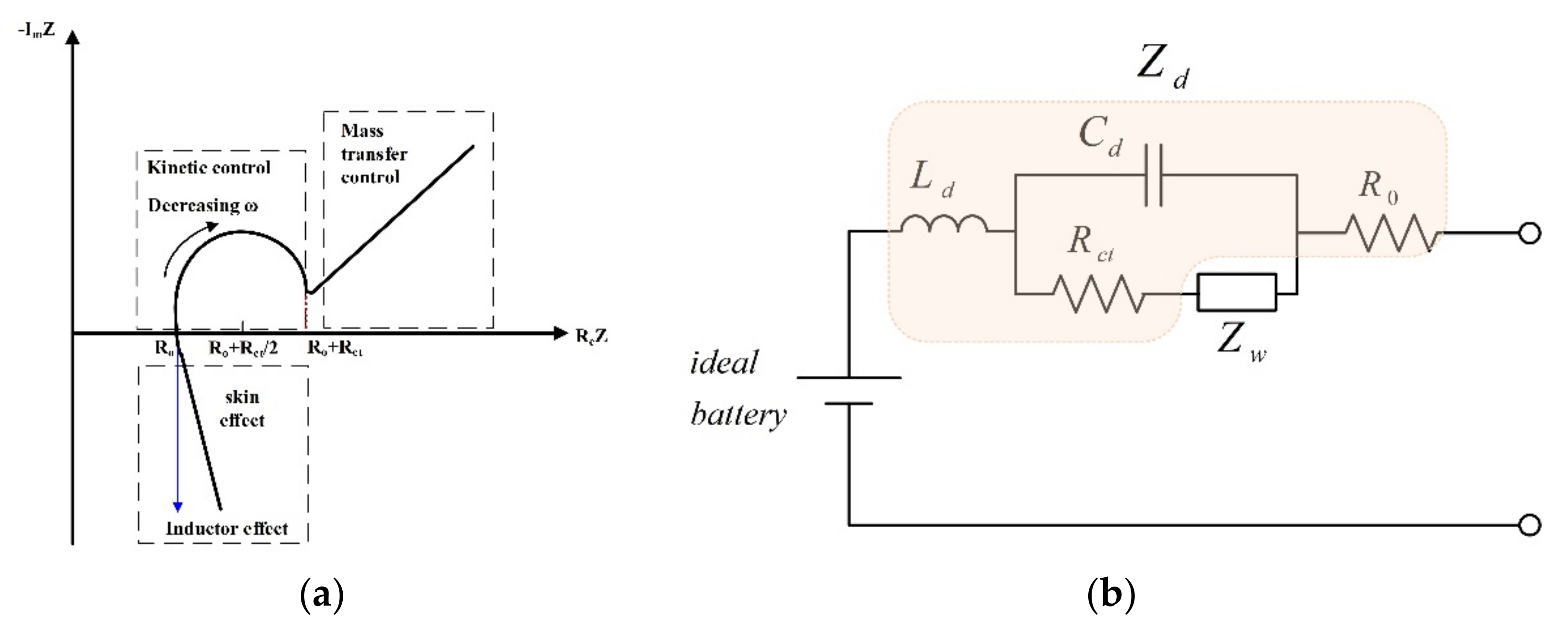
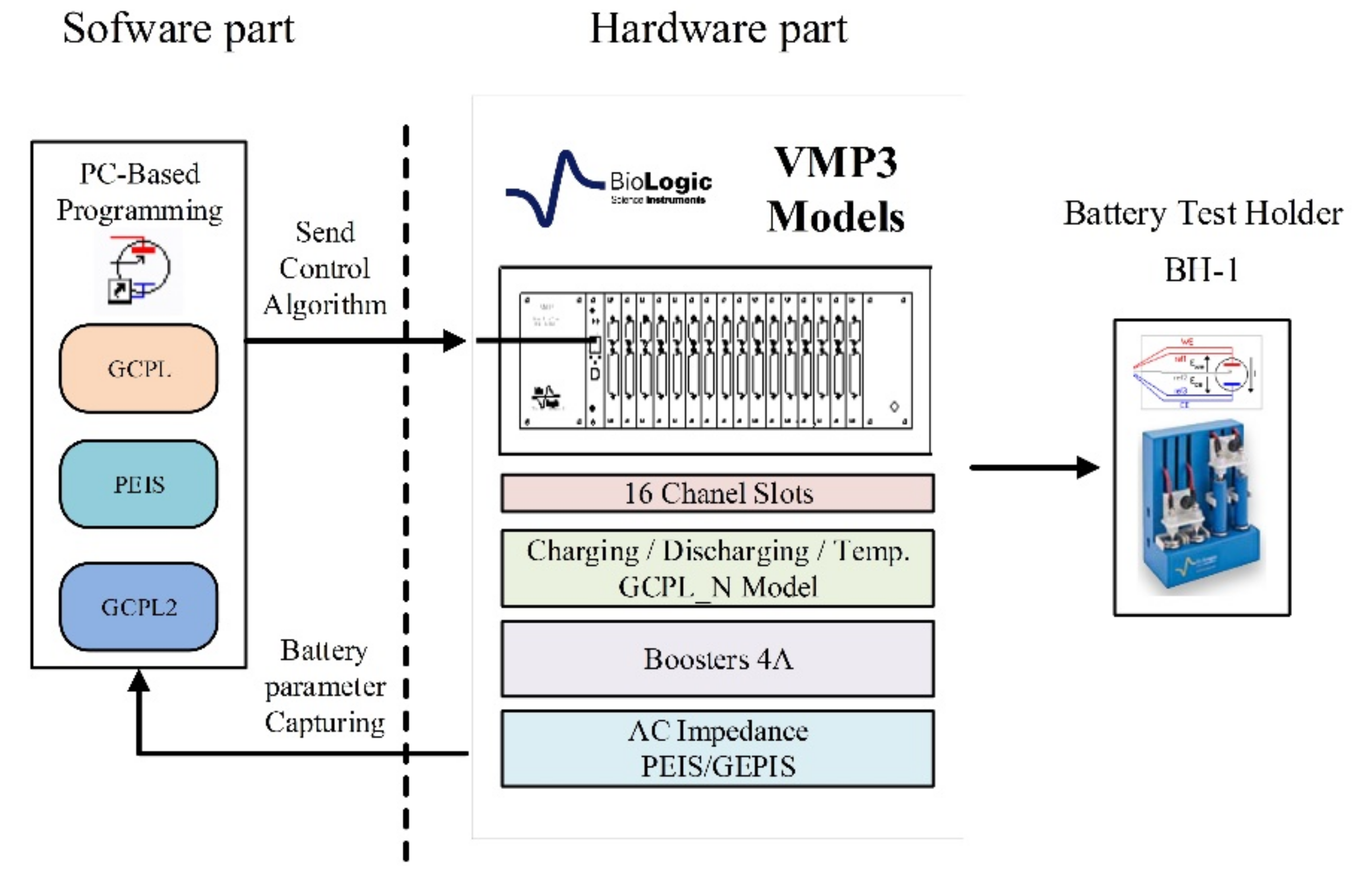
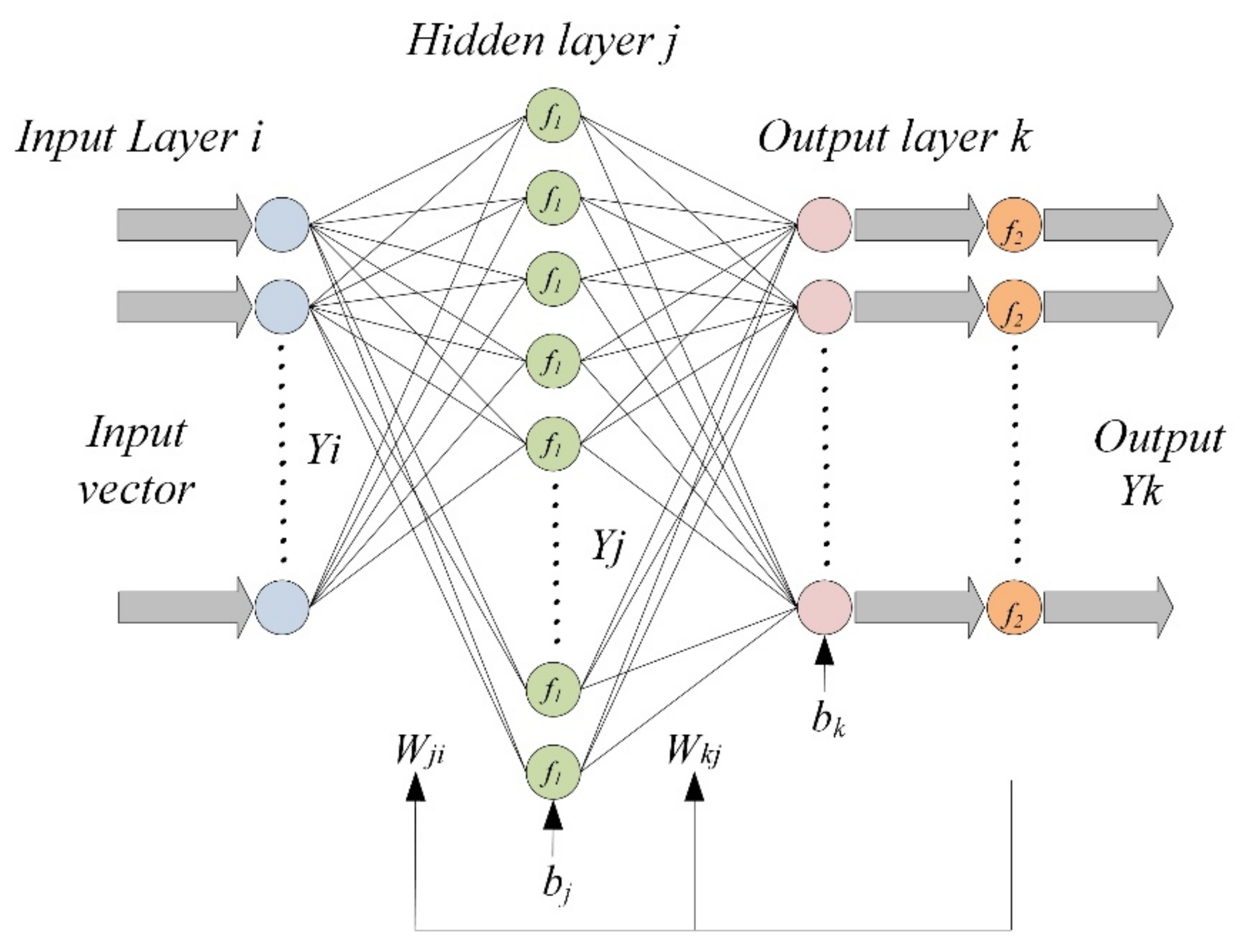
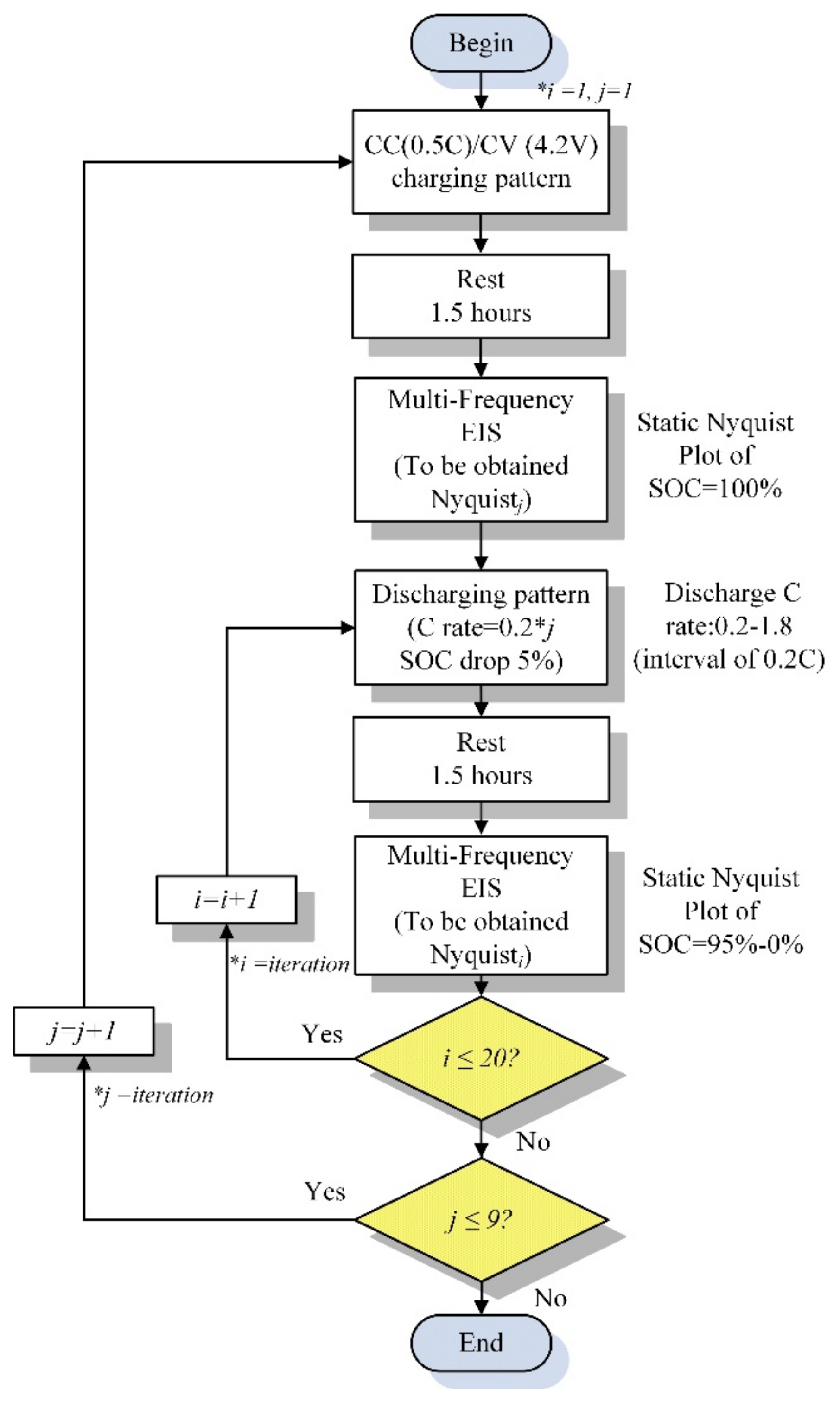


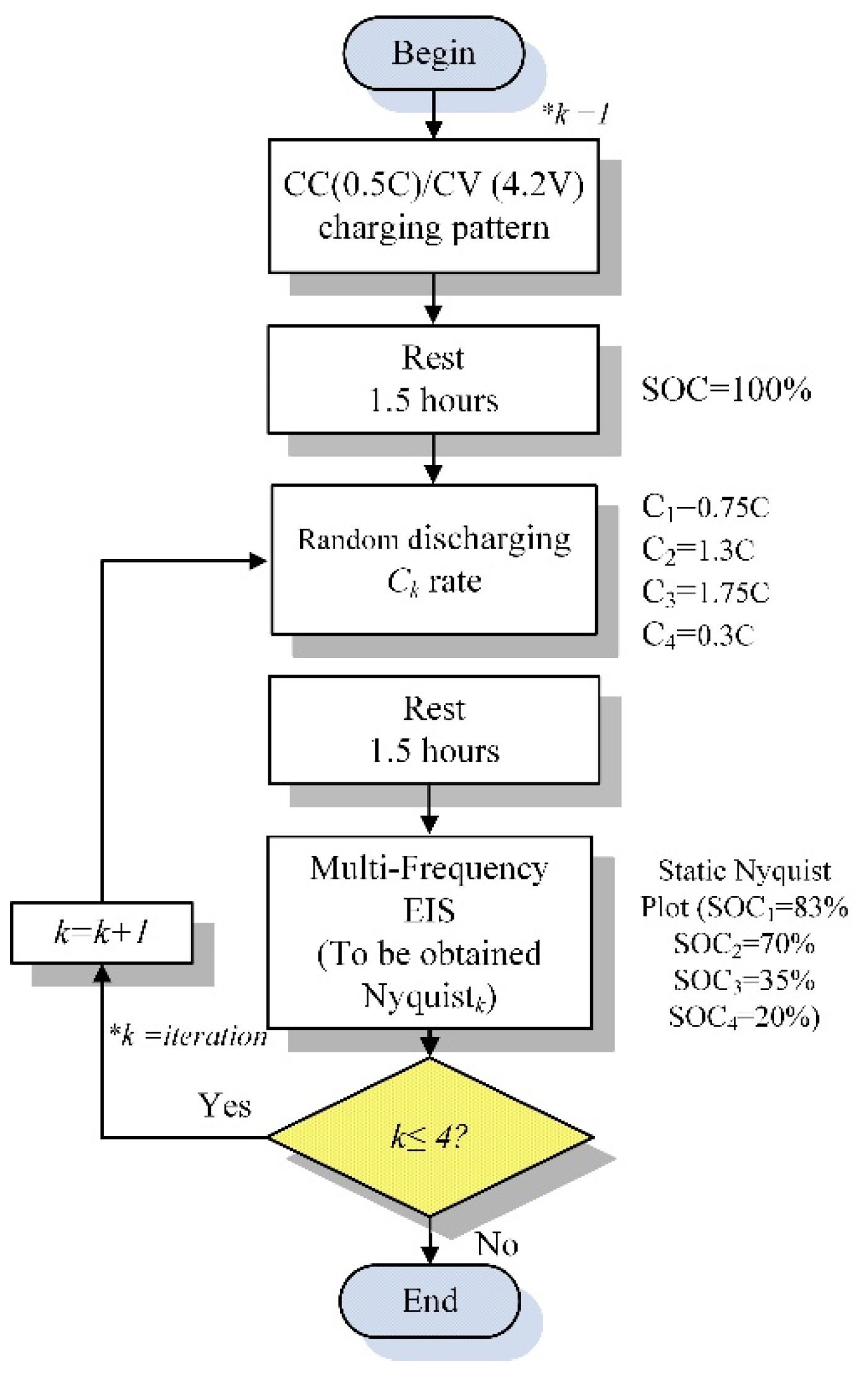
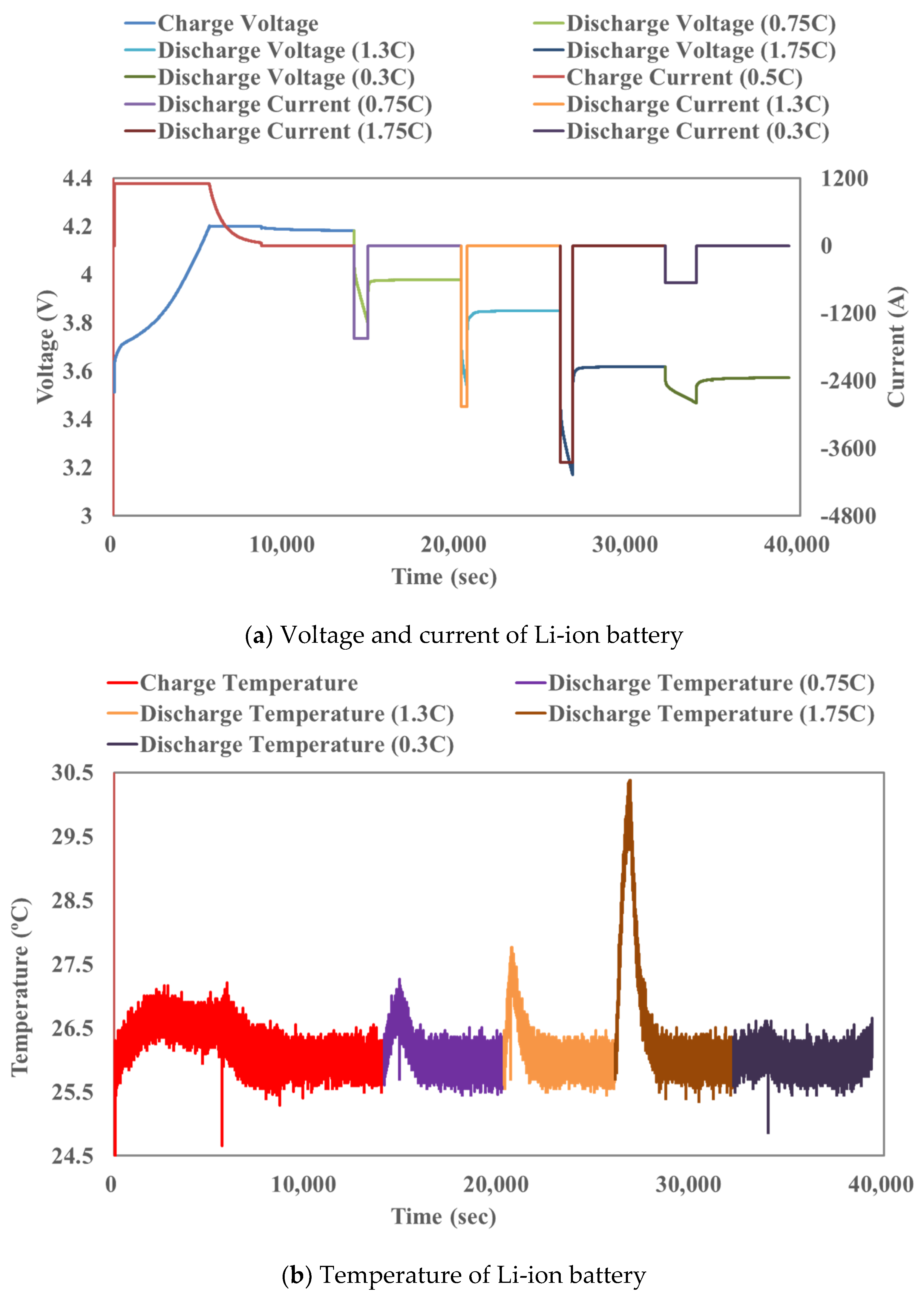
| Description | Parameter |
|---|---|
| Network Type | Feed forward backpropagation |
| Number of Layers | 2 (include hidden and output layer) |
| Layer1 number of neurons | 35 (hidden layer neurons) |
| Layer1 transfer function | Tansigmoid |
| Layer 2 transfer function | Purelin |
| Training method | Back-propagation neural network |
| Training function Adaption Learning Function | Trainlm (Levenberg–Marquardt) Leardgdm |
| Performance function | Mean square error |
| Input Value | Input 01 | Input 02 | Input 03 | Input 04 |
|---|---|---|---|---|
| Crate | 0.75 | 1.3 | 1.75 | 0.3 |
| Re (Z, f = 1001 Hz) | 0.061285 | 0.06165 | 0.063186 | 0.063667 |
| Re (Z, f = 100 Hz) | 0.063203 | 0.063599 | 0.065541 | 0.066083 |
| Re (Z, f = 463 Hz) | 0.068347 | 0.068957 | 0.071891 | 0.07295 |
| Im (Z, f = 1001 Hz) | 0.001553 | 0.001352 | 0.000725 | 0.000453 |
| Im (Z, f = 100 Hz) | −0.00188 | −0.00208 | −0.00287 | −0.00326 |
| Im (Z, f = 463 Hz) | −0.00403 | −0.00429 | −0.00539 | −0.00613 |
| Input Value | Outpu t01 | Output 02 | Output 03 | Output 04 |
|---|---|---|---|---|
| Target SOC | 83 | 70 | 35 | 20 |
| Estimation | Error (%) | Max. Error (%) | Min. Error (%) | Avg. Error (%) | |||||||
|---|---|---|---|---|---|---|---|---|---|---|---|
| SOC | 83 | 70 | 35 | 20 | 83 | 70 | 35 | 20 | |||
| Neur 15 | 80.6 | 73.4 | 36.9 | 21.9 | 2.86 | 4.89 | 5.43 | 9.63 | 9.63 | 2.86 | 6.21 |
| Neur 20 | 80.2 | 72.2 | 35.7 | 21.4 | 3.33 | 3.13 | 1.91 | 6.99 | 6.99 | 1.91 | 4.28 |
| Neur 25 | 81.6 | 72 | 33.2 | 19.8 | 1.69 | 2.86 | 5.01 | 1.01 | 5.01 | 1.01 | 3.05 |
| Neur 30 | 81.3 | 67.2 | 35.0 | 19.5 | 2.08 | 3.97 | 0.00 | 2.29 | 3.97 | 0.00 | 2.52 |
| Neur 35 | 81.2 | 69.8 | 35.5 | 20.5 | 2.20 | 0.34 | 1.54 | 2.73 | 2.73 | 0.34 | 1.92 |
Publisher’s Note: MDPI stays neutral with regard to jurisdictional claims in published maps and institutional affiliations. |
© 2021 by the author. Licensee MDPI, Basel, Switzerland. This article is an open access article distributed under the terms and conditions of the Creative Commons Attribution (CC BY) license (https://creativecommons.org/licenses/by/4.0/).
Share and Cite
Luo, Y.-F. A Multi-Frequency Electrical Impedance Spectroscopy Technique of Artificial Neural Network-Based for the Static State of Charge. Energies 2021, 14, 2526. https://doi.org/10.3390/en14092526
Luo Y-F. A Multi-Frequency Electrical Impedance Spectroscopy Technique of Artificial Neural Network-Based for the Static State of Charge. Energies. 2021; 14(9):2526. https://doi.org/10.3390/en14092526
Chicago/Turabian StyleLuo, Yi-Feng. 2021. "A Multi-Frequency Electrical Impedance Spectroscopy Technique of Artificial Neural Network-Based for the Static State of Charge" Energies 14, no. 9: 2526. https://doi.org/10.3390/en14092526
APA StyleLuo, Y.-F. (2021). A Multi-Frequency Electrical Impedance Spectroscopy Technique of Artificial Neural Network-Based for the Static State of Charge. Energies, 14(9), 2526. https://doi.org/10.3390/en14092526






